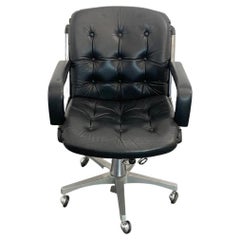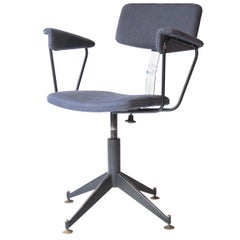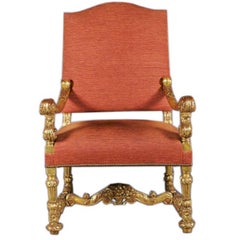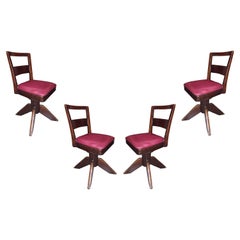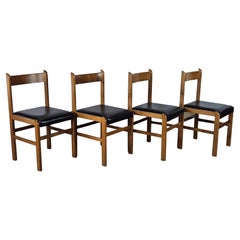Italian Office Chairs and Desk Chairs
to
40
199
85
213
53
29
Height
to
Width
to
Depth
to
212
106
55
65
40
56
35
52
34
43
30
42
130
60
8
8
4
4
4
3
2
2
1
1
1
7
9
197
82
4
92
88
1
1
4
2
24
40
49
26
6
195
127
124
92
109
1,396
753
676
321
295
295
248
260
22
21
12
9
9
Place of Origin: Italian
Leather and Steel Adjustable Swivel Armchair, 1970s
Located in Montelabbate, PU
Leather and Steel Adjustable Swivel Armchair, 1970s
Category
1970s Vintage Italian Office Chairs and Desk Chairs
Materials
Leather
Mid-Century Modern Grey Black Metal Brass German Rotating Armchair, Germany 1930
Located in Madrid, ES
Armchair with metal structure lacquered in black. Seat and arms upholstered in cotton fabric and feet finished in brass pads.
Category
1950s Mid-Century Modern Vintage Italian Office Chairs and Desk Chairs
Materials
Brass, Steel
Monumental 19th Century Baroque Style Giltwood Armchair
Located in Buchanan, MI
A monumental 19th century Baroque style giltwood armchair, very regal.
Category
19th Century Antique Italian Office Chairs and Desk Chairs
Materials
Wood
4 Chair, Italian, 1950
Located in Ciudad Autónoma Buenos Aires, C
4 Chairs
Country: Italian
If you are looking for a desk chair to match your desk, we have what you need.
We have specialized in the sale of Art Deco and Art Nouveau and Vintage styles since 1982.If you have any questions we are at your disposal.
Pushing the button that reads 'View All From Seller'. And you can see more objects to the style.
Why are there so many antiques in Argentina?
In the 1880 – 1940 there was a grate wave of immigration encouraged by the periods of war that were taking place.
1st World War took place between 1914 and 1918
2nd World War took place between 1939 and 1945
The immigrants options were New York or Buenos Aires. Tickets were cheap and in Buenos Aires they were welcomed with open arms, as it was a country where everything was still to be done.
Argentina was the country of new opportunities, labour was needed and religious freedom was assured, in many cases the of the family travel first until they were settled and then the rest of the family members join them.
In the immigrant museum “Ellis Island Immigrant Building” in New York you can se the promotional posters of the boats that would take them to a new life.
Between the years 1895 and 1896, Argentina had the highest DGP (gross domestic product) per capita in the world according to the Maddison Historical Statistics index, this situation arose due to the large amount of food being exported to European countries, which were at war.
The Argentinean ships left the port of Buenos Aires with food, but they returned with furniture, clothes and construction elements, (it´s common to see this the old buildings of the historic neighbourhood of San Telmo, the beams with the inscription “Made in England)”, as well as many markets that were built in Buenos Aires, such us the San Telmo Market, whose structure was brought by ship and afterwards assembled in 900 Defensa Street.
With the great influence of European immigrants living in the country, the children of the upper classes travelled to study in France, resulting in the inauguration of “La Maison Argentinienne”, on 27th of June 1928, in the international city of Paris, which hosted many Argentinians that were studying in Frace.
It´s the fourth house to be built after France, Canada and Belgium, being the first Spanish-speaking one. Still in place today (17 Bd Jourdan, 75014, Paris, France). Many of the children of these wealthy families who attended international art exhibitions, museums and art courses abroad, took a keen interest in the European style. This is why Buenos Aires was at the time referred as “The Paris of South America”.
Between the years 1890 and 1920 more than a hundred Palaces were built on Alvear Avenue the most exclusive avenue in Buenos Aires. Today some of these palaces have been transformed into museums, hotels and embassies.
In the year 1936, the Kavanagh building was inaugurated, it was the tallest reinforced concrete building in South America.
During 1994 the American Society of Civil Engineers distinguished it as an “international engineering milestone”, and it´s now considered a World Heritage of Modern Architecture.
At the time was common to hire foreign architects such as Le Corbusier, who visited Buenos Aires/Argentina in 1929 and in 1948 he drew up the blueprints for a house built in La Plata City (which was declared a World Heritage Site).
In 1947, the Hungarian architect Marcelo Breuer designed “Parador Ariston” in the seaside city of Mar del Plata. After an Argentinean student at Harvard University convinced him to come to Argentina. He worked on an urban development project in the Casa Amarilla, area of La Boca.
The Ukrainian architect, Vladimiro Acosta, arrives in Argentina in 1928 and worked as an architect until que moved to Brazil.
Antonio Bonet, a Spanish architect who worked with Le Corbusier in Paris, arrives in Argentina in 1937, where he carried out several architectural works and in 1938 designs the well-known BFK chair...
Category
1920s Space Age Vintage Italian Office Chairs and Desk Chairs
Materials
Wood
Set of four beech and leather chairs
Located in Premariacco, IT
Beechwood office or waiting room chairs with comfortable black leather upholstered seat.
The chairs are a high-quality Italian production, dating from the early 1970s.
They show no...
Category
1970s Mid-Century Modern Vintage Italian Office Chairs and Desk Chairs
Materials
Leather, Beech
Read More
Ask an Interior Designer: Work-from-Home Edition
Leaping into a design project, whether it's refreshing the bedroom or redoing the whole house, can be overwhelming. Luckily, we know more than a few interior designers. You asked questions on Instagram, and now they're answering.
18 Home Offices for Workaholic Design-Lovers
Proof that working from home is a perk.
